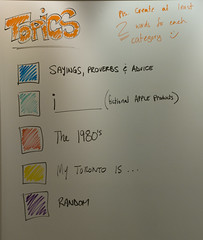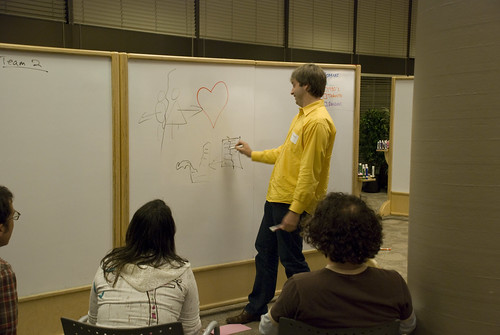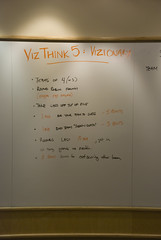Here in Toronto we just ran VizThink Toronto 5, a.k.a. "Vizionary!".
So what is Vizionary?
In a nutshell, a modified version of the family favorite "Pictionary". We took the basic premise and tweaked it to be played in a large group environment in a round-robin tournament style.
Overall I think it was a great success, when I posted the event I wasn't sure if I'd get anyone out as it wasn't a traditional "Come learn something from a speaker" kind of event. We ended up having 16 people show up so we played in four teams of four - which, in looking back was a pretty ideal size for a test group.
At the end of the day, running a Vizionary tournament is a pretty straightforward process and there isn't really a wrong way to do it.
What you'll need:
- Index Cards
Pick up a few packs of multi-coloured index cards from your local Office Supply Store. Figure on a minimum of about 10 cards per person attending to ensure you'll have enough words for the evening. - Sharpies
For writing on said cards - Vertical Writing/Drawing Surfaces
Whiteboards, easels, pads of paper etc. You'll need a drawing station for roughly every two teams you have playing. - Whiteboard Markers
If you use whiteboard surfaces for the game - Timing Devices
For each drawing station you'll need some way to keep track of time. Plus one master timer for the rounds.
Unlike Pictionary, which comes with a nice box of cards with lots of words on them, in Vizionary we make our own.
The first step is to pick some categories - for this initial version of the game I just brainstormed some categories with a couple of other people ahead of time. Ideally you could work in a session at the start to get the group involved in setting the categories for the evening. At this point though I was more concerned with the actual mechanics of the game etc. that I didn't want to add another level of complexity to the evening.
 Categories are a tricky thing - if they don't work the rest of the evening will suffer as they drive the context of the evening. Because the participants are creating the words there's a lot of room for some strange stuff to end up on the cards, as a result you need to find categories that have the following characteristics:
Categories are a tricky thing - if they don't work the rest of the evening will suffer as they drive the context of the evening. Because the participants are creating the words there's a lot of room for some strange stuff to end up on the cards, as a result you need to find categories that have the following characteristics:- Broad enough that there will be plenty of ideas and hopefully minimal repetition.
For example "Pets" would probably result in a LOT of "cat" & "dog" cards. - Lend themselves to unobvious concepts/pictures.
Taking the "Pets" example. "Cat" & "Dog" will be pretty much slam dunks. Especially in a room full of people with some artistic skill. But "Animals That Make Bad Pets" would probably end up with some interesting ideas. - Are not so obscure that most people wouldn't know the subject matter
"Architectural styles of the late 17th Century" - do I really need to expand on why this wouldn't work?
- Sayings Proverbs and Advice
- i______ (Fictional Apple Products)
- The 1980's
- My Toronto is...
- Random
Assign each category a colour of card and you're ready to go. As you can see in the picture above an extra whiteboard/pad & some coloured markers makes for a good legend.
2. Creating the "words"
So this is where we kicked of the participation portion of the evening. As people arrived we asked them to grab at least two cards for each category and come up with ideas (one per card). Within about 15 minutes we had a really healthy stack of cards that would get us through the game. If you do the basic math @ 2 ideas x 5 categories that's ten "draws" per person - Factor on each person drawing once per round you could run a game of ~9-10 rounds, or 18-20 teams playing each other once.
Again, there's another opportunity here to do an activity to get people stimulated and thinking creatively - the challenge though is you don't want the words seen by everyone as it will spoil a large part of the game. For the most part though I found people were pretty good at coming up with some pretty unique and interesting ideas.
Some notes to pass on to your group about the words though:
- It doesn't have to be just one word but keep in mind that there's only two minutes for someone to draw this concept so try and keep it brief (~5 words max)
- It should be commonly known. Unless you're with a very niche group of people keep the ideas in the "general knowledge" realm.
- At the same time avoid the obvious ideas - it's probably a good idea to throw out the first idea that comes to mind for a category as many others will probably think of it to.
- Have fun with them!
Ordinary Pictionary is a board game, but that really doesn't translate well to large groups of people. The structure that seems to work well is a round-robin, everyone plays everyone else format. For the nitty-gritty on how to schedule this kind of format check out Wikipedia's entry on it. It's quite straight forward.
It takes about 15-20 minutes to play a round if you have four people per team and they each draw once so keep that in mind when scheduling. We played for ~70 minutes and everyone seemed to be having a great time, we probably could have gone another 30 and still kept people engaged. That would work out to a 6 team round-robin game.
If you're lucky enough to have the problem of a lot of people, just split the teams out into "leagues" and have the teams only play other teams in their league:
Keep in mind that for every two teams you'll need one drawing surface (Whiteboard/Easel) - If necessary you could also play with having three teams play at a time.
Here's the rules we used:
For the person drawing:4. Go Have a BeerPoints & Timing:
- No talking.
- No letters or numbers.
- Feel free to gesture!
- Take the card on the top of the pile. If it's a card you made slide it back into the deck randomly
Most Importantly:
- The Drawing team gets one minute to guess. 5 points for guessing in the first minute.
- After one minute there's an additional one minute "All Guess" where both teams can guess. 3 points for guessing during this time.
- A Round is each person from both teams drawing once or 20 minutes, whichever comes first. Teams can keep drawing for fun if they're waiting for a round to end.
- Whichever team outscores their opponents in a round gets a bonus 5 points.
Our winning team that night was the group that throughout the night let it all hang out and even came up with their own secret code for the drawer to use to help break down the words/concepts.
- Have fun, step outside your comfort zone and go for it!
Finish the night off a local pub - there's nothing more fun than a group of VizThinkers with their "creative adrenaline" pumping at the end of the night. Some of the most interesting/fun stuff comes out of the "over-beers" conversations.
If you do run a Vizionary! night let us know how it goes - and defenitely let us know of any modifications or adaptations you make. These things are a work in progress so feel free to innovate and improve on it!





